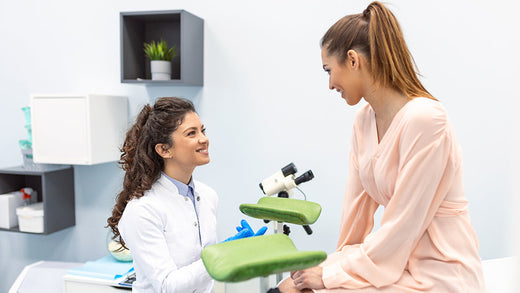At-home HPV testing for cervical cancer screening could help many patients who have missed their cervical screening during lockdown
Find out moreAt-home HPV testing is a safe and effective way to perform cervical screening that will reduce the number of smear test appointments that are needed, GP and hospital visits and invasive procedures by 90%.
At-home HPV testing should be accelerated by NHS England to cope with the increasing waiting lists of women due for cervical cancer screening, and lessen the impact of falling attendance rates for cervical screening.

Professor Gordon Wishart, Chief Medical Officer at Check4Cancer
As the end of another cervical cancer prevention awareness week, there is much to be positive about in the global mission to eradicate cervical cancer. Some of the first girls who received the HPV vaccination in 2008 at age 12-13 have now started cervical screening at age 25, and boys now receive the vaccine at the same age as girls. The NHS now initially screens women for the human papillomavirus (HPV), the cause of 99.8% of all cervical cancer, and only examines the cervical cells for any abnormalities if HPV is detected. Together, the strategies of HPV vaccination and regular screening should have a significant impact on the incidence and mortality from cervical cancer in the UK and other countries, provided that acceptance rates for screening are maintained.
During lockdowns in 2020-2021, many women have missed their cervical screening appointment, and there does not seem to be adequate capacity to catch up on this backlog using the traditional GP-led screening pathway. As a result, many women have experienced significant delays in screening and, potentially, in a diagnosis of cervical cancer. During cervical awareness week, Jo’s Cervical Cancer Trust called for faster action on HPV self-sampling as a way to tackle screening attendances that have been falling during the last two decades and, have now been accelerated by the pandemic and successive lockdowns. Their call to action was supported by their survey which reported that 62% of women would prefer self-sampling to clinician sampling if it was easy and reliable and, 31% of women said they were less likely to, or would definitely not, attend their screening appointment.
How accurate is at-home testing for HPV cervical screening?
A Scottish study published in the British Medical Journal (BMJ) in 2016¹ reported that HPV testing on self-samples was as accurate as clinician samples at detecting early cancerous change and, that it justifies consideration for primary screening. A review of 81 studies published in the BMJ 2018 also concluded that self-sampling was as effective as clinician sampling, and a more effective way to reach under-screened women². At Check4Cancer, we have helped many women access an at-home HPV test for cervical screening and we can report that it has been extremely well accepted with high patient satisfaction, with 9% of women having a positive HPV result following the at-home test.
The Dutch cancer screening programme has used primary HPV testing since January 2017 and, participants have the option to request a self-sample collection. In a recent review of more than 450,000 patients³, more than 36,000 used the self-sampling option and the overall rate of HPV-positivity was 9% which concurs with our own audit data. Despite the HPV test being accurate, actual analysis of the cells for cancerous changes in self-sample material is unreliable, and therefore women who are HPV positive on self-sampling were invited to have a smear test by their GP. Overall, 3% of all patients were finally referred to a gynaecologist for further investigation and/or treatment.
Response from CRUK
Despite the advice from Jo’s Trust that introduction of “self-sampling would be a game changer”, the response from Cancer Research UK was that the accuracy and effectiveness of self-sampling was “not yet known” in cervical screening. Dr Jodie Moffat, Head of Early Diagnosis at CRUK, was quoted as saying that “research was underway to understand how effective and accurate self-sampling could be in cervical screening”. This response from CRUK is misleading and difficult to understand, as the published evidence from many studies clearly demonstrates that self-sampling is as accurate as clinician sampling and, an effective way to reach under-screened women. CRUK’s stance will have worried many women who have had a self-sample HPV test in recent years and furthermore, unless the evidence on the accuracy of self-sample tests was robust and accurate, why would the NHS be running pilot studies in North London and Scotland to find out how best to introduce these tests in the future?
CRUK also advised that the NHS was under immense pressure and that more staff and equipment would be needed to ensure patients receive results and treatment as quickly as possible. However, with the introduction of at-home HPV tests, only 10% will test positive for HPV and proceed to a traditional smear test, meaning that 90% of women avoid an appointment to have a smear test altogether. Under current restrictions, this would allow 90% of women to avoid visiting their GP or hospital and be quickly reassured about their negative result, and significantly reduce the number of invasive procedures carried out by clinicians.
It is clear that the NHS is already thinking about self-sampling, and pilot studies are underway in both England and Scotland. NHS England has shown many times during the coronavirus pandemic that it can make quick decisions based on scientific evidence, so I would therefore encourage NHS England and CRUK to review the scientific evidence and consider early adoption of self-sampling to help manage the backlog of women who will become increasingly concerned about the delay to their screening appointment.
References
1. Stanczuk G, Baxter G, Currie H et al. Clinical validation of hrHPV testing on vaginal and urine samples in primary cervical screening (cross-sectional results from the Papillomavirus Dumfries and Galloway – PaVD&G study). BMJ Open 2016; 6: e010660.https://bmjopen.bmj.com/content/6/4/e010660?int_source=trendmd&int_medium=cpc&int_campaign=usage-042019
2. Arbyn M, Smith SB, Temin S et al. Detecting cervical precancer and reaching underscreened women by using HPV testing on self samples: updated meta-analyses. BMJ 2018; 363: k4823. https://www.bmj.com/content/363/bmj.k4823
3. Aitken CA, van Agt HME, Siebers AG. Introduction to primary screening using high-risk HPV DNA detection in the Dutch cervical cancer screening programme: a population-based cohort study. https://bmcmedicine.biomedcentral.com/track/pdf/10.1186/s12916-019-1460-0

Professor Gordon Wishart
Chief Medical Officer
Professor Gordon Wishart is the founder, Chief Medical Officer and CEO of Check4Cancer, a leading early cancer detection and cancer prevention company. In 2016 Check4Cancer launched rapid access, streamlined and audited diagnostic pathways for breast and skin cancer to the insured and self-pay markets, leading to the award of “Diagnostic Provider of the Year” at the annual Health Investor Awards in 2018. In late 2017, Check4Cancer launched the first worldwide breast cancer risk test (MyBreastRisk) to combine genetic, family history and lifestyle risk factors to underpin a risk-stratified breast screening programme. As the former Director of the Cambridge Breast Unit from 2005-2010, and current Professor of Cancer Surgery at Anglia Ruskin School of Medicine since 2008, he has a strong track record in clinical research and modernisation of cancer diagnosis and treatment, with more than 100 peer-reviewed papers in scientific journals. In 2010 he led a team of clinicians and scientists that developed the PREDICT breast cancer treatment and survival model, now used worldwide.
Find out moreKnowledge and support
Go to all articles
HPV Awareness Day
The International Papillomavirus Society (IPVS) established March 4th as HPV Awareness Day, in 2018. It provides an opportunity to highlight...
Read more
What is HPV and What are the Symptoms?
Understanding HPV, how it spreads, its symptoms, and how to protect yourself is crucial for maintaining your health.
Read more
Does A Smear Test Hurt?
What happens at a smear test, does it hurt or not, what to do if you experience any side effects...
Read more